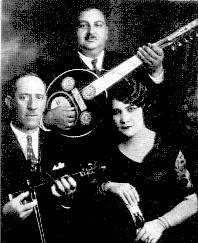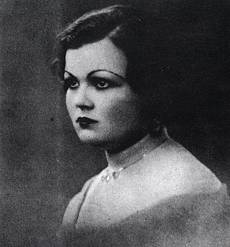| The revival of interest in Asia Minor music and the
proliferation of cafes aman in Athens after the
Turko-Greek War of 1920-1922 with its consequent exchange
of populations is hardly surprising. The sheer numbers of
refugees created an audience for the music and there were
many musicians among them. More importantly, the already
established associations of the amanedhes with
laments, articulated in Phaidros's essay, made them an
ideal vehicle for the expression of the refugees'
nostalgia for their lost homeland. Amanedhes were
still showpieces for the vocalists, but they were also,
as Kazantzakis correctly observed, a cry of bitterness
that rose from their innermost being and spelled, to
singer and audience, the Orient they had been forced to
abandon. For the newly arrived refugees, the cafes aman of Athens were places to gather and collectively mourn the loss of their homelands while at the same time enjoying the fine musicianship of the artists who had emigrated from Istanbul or Smyrna. These artists soon made a large impact on the local Greek musical scene. Aksoy (1998: 4) notices an acceleration of borrowed melodies from Turkish music in rebetika songs of the post 1922 period; at the same time many recordings were made of amanedhes with Greek or a mixture of Greek and Turkish words. Although the cafes aman themselves were at their height of popularity in the years immediately following the war, recordings of cafes aman style music, including amanedhes, remained popular during the 1930s. Whereas Turkey and the United States had been the centers of the recording industry for Asia Minor Music before the exchange of populations, from 1922 on, Athens became an important center of recordings. Even before the major studios were set up in Greece, the Gramophone Company (later HMV) had sent a team to Greece, where they recorded various types of Greek music, none of it in the Asia Minor style. By 1924, when Odeon sent another team of talent scouts to Greece, the musical scene had changed dramatically. Using a Salonika firm as their agents, Odeon conducted eight recording session in Athens between 1924 and 1925. The success of their recordings caused three other recording companies (Gramophone, Columbia and Polydor), to join the competition, making recordings in Athens and other Greek towns. Of the recordings made between 1925 and 1929 by these companies, approximately 30% were in the Asia Minor style. The titles given to these recordings by the Gramophone Company, in addition to 'rebetika' are 'manes Constantinople' and 'manes Smyrna'.
The most earthy and perhaps the most distinctive of the Greek female vocalists of the 1930s, Rita Abadzi, made a series of outstanding recordings of amanedhes. She is accompanied by the brilliant Asia Minor style violinist Dimitrios Semsis in several of these recordings. On an HMV recording of Manes Karip Hetzaz made around 1935 (OGA-285B. A.O. 2306) (8) she sings an amanes that seems uniquely adapted to the plight of the refugees and close in spirit and sentiment to the many Greek folk songs about ksenitia (foreign lands). These songs often concern the loss of sons, husbands or other male kin who have gone abroad.
Another amanes that is close not only in spirit but in verse to a traditional miroloyi is the Gazeli Nava Sabach again recorded by Abadzi in Athens (this recording is included in Schwartz, 1991, and dated by him as ca. 1935).
To anyone familiar with the Greek folk tradition, it is impossible not to see this bleak amanes as a form of lament. Despite the wide variety of music performed and recorded by the Asia Minor musicians in the decade following the exchange of populations, the fact that amanedhes became synonymous with the music of the cafe aman (Gauntlett 1989: 13-15) suggests that they had become emblematic of what Greeks either admired or disliked about the music performed in these establishments. The melismatic style of the amanes was not unknown in Greek music (the same artists who recorded amanedhes often recorded kleftika - heroic songs about brigands who fought the Turks that were also characterized by vocal ornamentation - and there were obvious parallels in the music of the Orthodox Church) but it was quite foreign to the light popular music imported from Europe and to the music of the cabarets and musical theater becoming popular in Athens. It had more in common, indeed, with what could legitimately be called traditional Greek music than it did with European, but it came at a time when many bourgeois Greeks looked to Europe for their cultural models. It may also have reinforced the prejudice of local Greeks towards the newcomers as representatives of a somewhat different form of Greekness, one that had ties to a past they preferred to forget. The debate that arose in the columns of Ta Athinaika Nea in 1934 over whether amanedhes should be banned in response to a rumor that the Kemalist government had banned them in Turkey, made the association of these songs clear (Gauntlett 1989). The Turkish ban was said to be part of a campaign of modernization and Europeanization. Greeks now had to face the issue of whether Greece could afford to be considered less European by allowing the offending oriental dirges to be sung in its public cafes. The response to a survey conducted by the newspaper was a spirited defense of the genre by 'experts' such as the composer Manolis Kalomiris, on the grounds that amanedhes were derived from ancient Greek music via Byzantium. Either Phaidros's article had borne fruit, or the interviewees reflected the tendency of Greek nationalists to accept their 'oriental' heritage provided it was passed through the filter of antiquity. In either case, the experts consulted recognized the amanedhes as intrinsically more interesting than the music presented in the rival establishments - the cafes chantants. Despite the championing of the music of the cafes aman by respected figures in the music world of Athens, there were calls from the newspaper's own music critic for the banning of the amanedhes and for raising the taxes on imported recordings of such music from the U.S. The desire of local urban Greeks to establish a form of popular music that was firmly based in Greece rather than Asia Minor may have contributed to the success of the Piraeus style rebetika.. Some of the refugee musicians were attracted to the low-class music of the Piraeus manges (sing. mangas), and joined ensembles that played bouzouki as their principle instrument. At first these rebetika songs, especially in their instrumental solos, had much in common with the Asia Minor music, and there was considerable cross fertilization between the two styles. The refugee musician Stratos Payioumdzis, for example, recorded both rebetika songs and amanedhes, and other refugees moved between one style and another, although the orchestration of the two remained distinct. By 1935, however, the bouzouki style rebetika began to attract a wider audience at the expense of the cafe aman style. The reasons for the success of the all-male Piraeus-based rebetika take us back to Greek perceptions of the nature of the amanes, and the fact that the bouzouki appears to have become, for many Greeks, the symbolic instrument of a new hybrid style of urban music. Debate continued in the Athenian press about what would probably now be called the 'political correctness' of various types of urban music, but the bouzouki-backed rebetika songs of the so-called Piraeus style gradually took center stage as the amanes faded from the repertoire, its traces still evident in the interpolated exclamations of aman! aman! which continued to be a common feature of the rebetika as well as of other types of Greek folk music. The censorship imposed by Metaxas on rebetika, followed closely by the war and the German occupation of Greece which resulted in widespread starvation, particularly in the urban centers, turned rebetika into a form of covert protest (9). At a time when most Greeks were united in their resentment towards the occupying power, the Piraeus rebetika, with their generally unsentimental lyrics, their strident combination of bouzouki and baglama, and their male dances, seemed more suited to represent the public mood of suppressed anger than the nostalgic Asia Minor amanedhes. |

